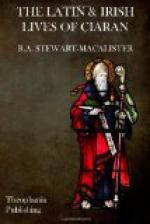There is another pedigree, totally different, which connects the saint, not with the Tara kings, but with those of the Ulaid or Ulster folk, through the dethroned Fergus who figures so prominently in the epic tale Tain Bo Cualnge. This pedigree appears in the Book of Leinster (facsimile, pp. 348, 349) and Leabhar Breac (facsimile, p. 16), the Bodleian MS. Rawlinson B 506, p. 154 d, and in the MS. in Marsh’s Library containing LA, at the foot of the column where LA begins; with an added note stating that Ciaran was “of the true Ultonains of Emain”: its authenticity is adopted by Keating (I.T.S. edition, vol. iii, p. 48). Correcting one copy with another this genealogy runs as follows—
Ciaran son of Coscrach son of Aislithe son of Beodan " Mesinsuad " Modruad " Bolcan " Mesinsulad " Follomain " Linned " Erce " Deoda " Corc " Erc (or Oscar) " Eochaid " Daig " Mechon " Corc " Cunneda " Nechtan " Fergus " Cass " Aed Corb " Ros " Froech " Aed Gnoe " Rudraige
Thus both genealogies claim a royal descent for the saint. This is an instance of a widespread policy, of which many traces are to be found in the old Irish Genealogies. The whole country was divided into territories of different clans, under which were subordinate and tributary septs. The latter bore the chief burden of taxation; and they were for the greater part composed of descendants of the aboriginal pre-Celtic tribes, who had been reduced to vassalage on the coming of the Celtic-speaking invaders (about the third or fourth century B.C.). When a tributary sept became strong enough to resist the pressure of these imposts, exemption was claimed by a sort of legal fiction, by which they were genealogically affiliated to the ruling sept. This practice led to the fabrication of spurious links, and even of whole pedigrees.
In point of fact several indications show that Ciaran belonged to a tributary sept, and was of pre-Celtic blood. These tributary septs were distinguished from their Celtic conquerors by social organisation, racial character, and probably still to some extent by religion and language. They had much the same position as the perioeci in ancient Sparta. The following are the evidences of his pre-Celtic nationality—
(a) The tribal names of his parents (Latharna, Glasraige). There are two forms of tribal names in ancient Ireland; those consisting of two words, and those consisting of one. The first are in such formulae as “tribe of NN,” “seed of NN” or the like—NN being the name of a more or less legendary ancestor. The second are either simple names which cannot be analysed, or else are derived from an ancestral name by adding the suffix _-rige_ or _-raige_. As a rule the names consisting of one word only are fundamentally pre-Celtic, or denote pre-Celtic septs, though in many cases they have been fitted with Celticising genealogies.




